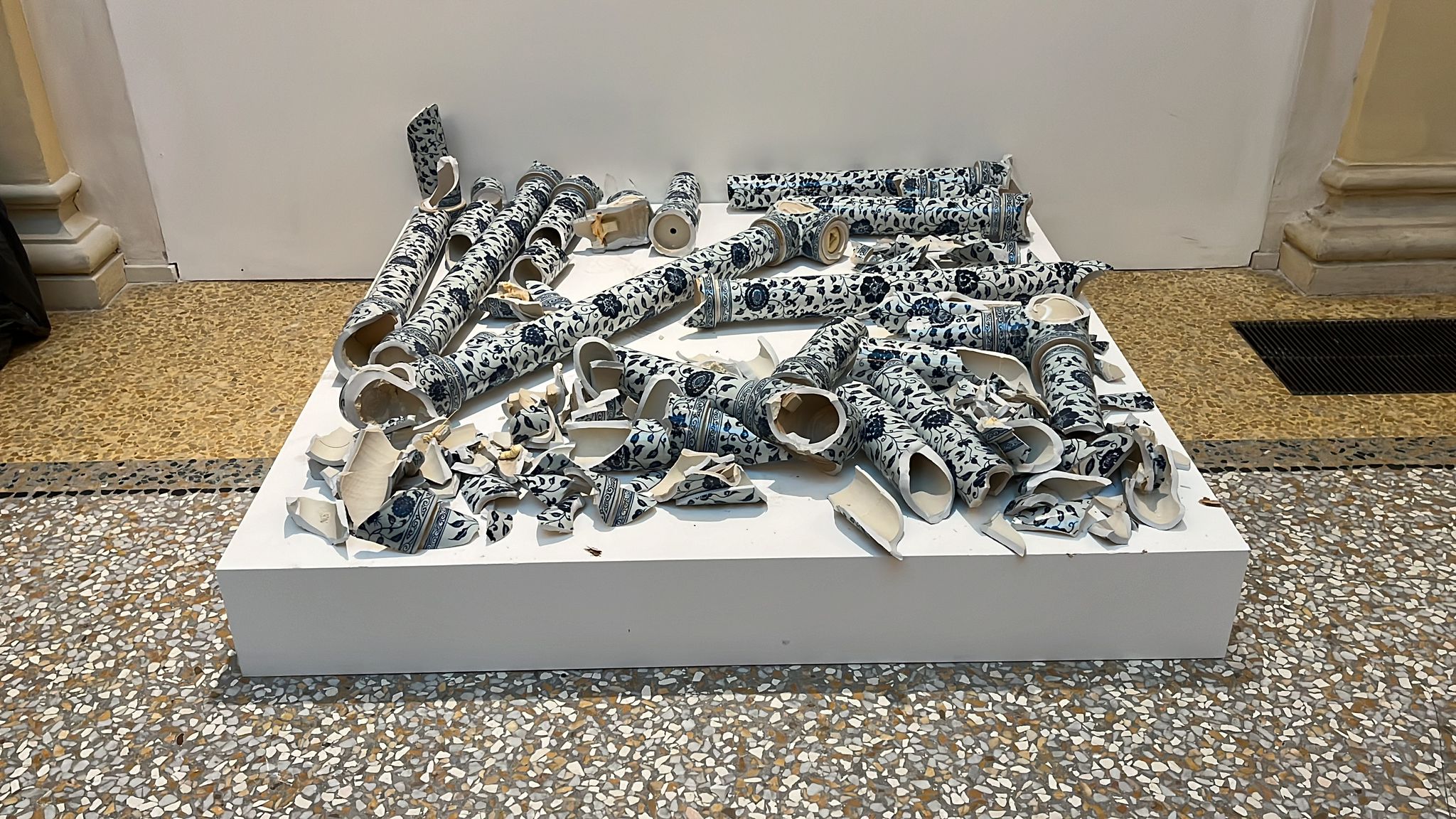
Every gallery-goer’s worst nightmare is to accidentally knock into a priceless ceramic. But one man who snuck into an Ai Weiwei exhibition in Italy on Friday was clearly planning to cause a scene when he toppled a porcelain sculpture by the Chinese dissident artist.
The man destroyed the large blue and white Porcelain Cube at a busy private opening for the exhibition “Who am I?” at Palazzo Fava in Bologna on the evening of September 21. Local police arrested a 57-year-old Czech man who has been identified in Italian media as Vaclav Pisvejc, a provocateur and self-proclaimed artist known for targeting important works of art.
It is not clear how the perpetrator gained access the invitation-only event but the museum has confirmed that the exhibition opened to the public as planned. In accordance with the artist’s wishes, the fragments were covered with a cloth and removed. They will soon be replaced by a life-sized print of the work and a label explaining what happened.
On Instagram, Ai shared CCTV footage in which the man is seen loitering by the work before he suddenly moves behind it and forcefully pushes it forward so that it smashes across the gallery floor. He proudly holds up a broken fragment in a triumphant gesture before several suited men tackle him, pulling him off the work’s raised platform and onto the floor.
“The sound of the destruction was so loud, resembling an explosion, that I initially thought it was a terrorist attack,” said Ai this morning by email. “Chaos ensued.”
The artist’s first concern was to ensure nobody had been harmed by the incident. “Afterward, I felt it’s a pity as the artwork had been incredibly difficult to create,” he said. “Crafted using the finest blue-and-white qinghua porcelain techniques from Jingdezhen, it required numerous attempts and a lot of experiments to produce.”
The unique piece took over a year to make using a traditional kiln. “Only true connoisseurs of the Yuan and Ming dynasties’ porcelain can appreciate the effort and style behind it,” said Ai, adding that he is not inclined to attempt a replacement and that these sorts of incidents are “part of the reality” of a divided society.
Ai Weiwei revealed that the perpetrator had approached him two days earlier, ahead of the show’s installation, demanding that he read “around 20 handwritten pages of notes” on the artist’s book 1,000 Years of Joys and Sorrows. Ai explained that he doesn’t speak Italian and the man suggested he find an interpreter.
Ai Weiwei’s Porcelain Cube was intentionally destroyed by a vandal at Palazzo Fava in Bologna on September 21, 2024. Photo courtesy of Ai Weiwei.
“I felt the request was odd and told him I wasn’t prepared to read the notes. I encounter people like this from time to time,” said Ai. “I wasn’t interested in engaging with him. I handed his notes to the staff of Galleria Continua and thought nothing more of it, though I often saw him sitting alone in the café.”
Ai himself is known for smashing works as well. The exhibition’s curator Arturo Galansino noted that several works in the show document the destruction of a precious ceramic. The most famous of these is Dropping a Han Dynasty Urn (1995), a triptych of black-and-white photographs in which the artist holds and then drops a 2,000-year-old vessel. It is a commentary on China’s deliberate erasure of its cultural heritage.
“The destruction that Ai Weiwei depicts in his works is a warning against the violence and injustice perpetrated by those in power,” he said. “[It] has nothing to do with this reckless and senseless act carried out by a habitual troublemaker seeking attention by damaging artists, works, monuments, and institutions.”
Vaclav Pisvejc, who has been identified in Italian media as the man who allegedly smashed Porcelain Cube, has a long history of targeting important works of art. Last year, he was arrested for climbing the statue of Hercules and Caus in Florence’s Piazza della Signoria while stark naked.
Chinese artist Ai Weiwei attends the preview of his exhibition “Who Am I?” at Palazzo Fava on September 20, 2024 in Bologna, Italy. Photo: Roberto Serra – Iguana Press/Getty Images.
A year prior, Florence shrouded the copy of David in Piazza della Signoria with a black veil in mourning. Pisvejc set this drape alight, causing €15,000 in damages to the statue and resulting in a six month prison sentence and €26,000 fine.
Pisvejc has also taken aim at contemporary creations. In 2018, he used a spray can to deface a work by Urs Fischer installed in Piazza della Signoria. That same year, Pisvejc attacked Marina Abramović as she was leaving a book signing at Palazzo Strozzi. At first he appeared to be presenting the Serbian performance artist with a portrait he had painted of her as a gift, before he whacked her over the head with it. Rather than press charges, Abramović asked to speak to Pisvejc, who told her he had to assault her “for his art.”
According to Galansino, incidents like these and the destruction of Porcelain Cube are not done in protest, but rather “to bring attention to [Pisvejc’s] practice of vandalism.”
He said that many museums worldwide are struggling to protect works from various kinds of vandalism, including those by political protestors. At Palazzo Strozzi, where Galansino is director, “we have a very careful group of guards but it’s very difficult to prevent people with bad intentions. You can have a metal detector but that’s for knives. If someone wants to push a sculpture it’s very difficult.”